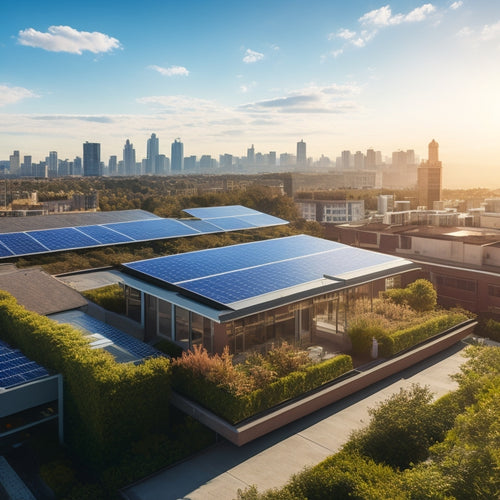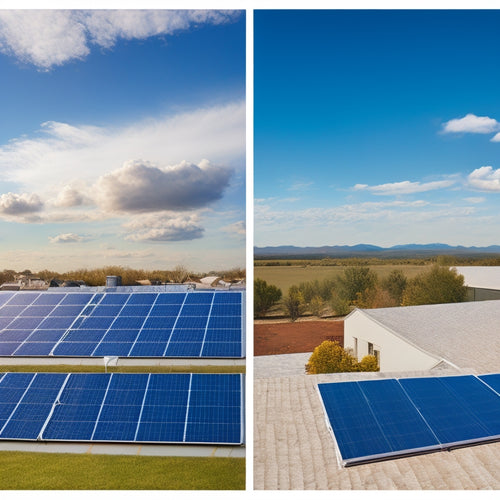
Texas Home Solar Panel Installation - 5 Steps to Go Solar
Share
You're taking the first step towards utilizing renewable energy by considering a Texas home solar panel installation, a smart move that can greatly reduce your carbon footprint and energy bills. To get started, you'll need to determine your energy needs by reviewing past utility bills and identifying peak energy consumption hours. Next, choose the right solar panels based on efficiency ratings, durability, and cost. Assess your roof's condition, confirming it's suitable for installation, and select a qualified installer with certifications and good customer reviews. Finally, plan for installation day by clearing the area and understanding the process. Now that you've begun, you'll want to investigate each step in more detail to guarantee a seamless shift to solar power.
Key Takeaways
- Assess energy needs by reviewing past utility bills and identifying peak consumption hours to determine the right system size.
- Choose the right solar panel by evaluating efficiency, durability, cost, and warranty to ensure a reliable renewable energy source.
- Ensure a suitable roof by examining material, orientation, and condition, and addressing any structural issues before installation.
- Select a qualified installer by researching certifications, experience, and customer reviews, and inquiring about warranties and guarantees.
- Plan for installation day by confirming the schedule, understanding the process, and implementing safety measures to protect family and pets.
Determine Your Energy Needs
Your energy consumption patterns play an essential role in determining the size and type of solar panel system you'll need for your Texas home.
To get an accurate assessment, review your past utility bills to understand your energy usage habits. This will help you identify the peak hours of energy consumption and the total amount of energy you need to power your home.
Considering your energy needs will also help you take advantage of available solar incentives, which can greatly reduce the upfront cost of installation.
Additionally, understanding your energy consumption patterns will enable you to make an informed decision about incorporating battery storage into your system, which can provide backup power during grid outages.
By choosing the right system size, you'll minimize maintenance costs and maximize the environmental impact of your solar panel system.
Choose the Right Solar Panel
Now that you've determined your energy needs, it's time to select the right solar panel for your Texas home. With various solar panel types available, it's crucial to take into account factors like efficiency ratings, durability, and cost.
Monocrystalline silicon solar panels offer high efficiency ratings, typically above 20%, but come at a higher price point. Polycrystalline silicon solar panels, on the other hand, have lower efficiency ratings (15-18%) but are more budget-friendly.
Thin-film solar panels are another option, offering lower efficiency ratings (7-14%) but being more flexible and durable. Reflect on the warranty and lifespan of the solar panels, as well as their certification and compliance with industry standards.
When evaluating efficiency ratings, keep in mind that higher ratings don't always translate to better performance. Assess the panel's temperature coefficient, which affects its performance in hot Texas summers.
Ultimately, choosing the right solar panel for your Texas home involves balancing efficiency, cost, and durability. By weighing these factors, you'll be able to select a solar panel that meets your energy needs and provides a reliable source of renewable energy for years to come.
Assess Your Roof's Condition
Before installing solar panels on your Texas home, it's essential to evaluate your roof's condition to guarantee a safe and secure installation. This involves examining your roof's material, orientation, and overall structure to confirm it can support the weight of the solar panels.
Here's a checklist to help you evaluate your roof's condition:
| Roof Material | Suitable for Solar | Considerations |
| Asphalt Shingles | | May require additional installation materials |
| Metal Roofing | | May require special mounting hardware |
| Clay or Concrete Tiles | | May require additional structural support |
| Slate Tiles | | May require special handling and installation |
| Wood Shakes | | May require additional maintenance and repair |
When evaluating your roof's orientation, consider the direction it faces and the amount of shade it receives. A south-facing roof with minimal shade is ideal for solar panel installation. Additionally, inspect your roof for any signs of damage, wear, or aging, and address any issues before installing solar panels. By doing so, you'll confirm a safe and secure installation that meets local building codes and regulations.
Select a Qualified Installer
A reputable solar panel installer is the linchpin of a successful Texas home solar panel installation, as they bring the necessary knowledge and equipment to secure a safe and efficient installation.
You'll want to research and evaluate potential installers based on their certifications, experience, and customer reviews. Look for installers certified by organizations like the North American Board of Certified Energy Practitioners (NABCEP) or the International Association of Electrical Inspectors (IAEI). These certifications confirm the installer has the necessary training and skill to handle your installation.
When evaluating installers, also inquire about their installation warranties and guarantees. A reputable installer will stand behind their work and provide a thorough warranty that covers the system's performance, parts, and labor.
Be wary of installers who don't offer a warranty or have a poor reputation. By selecting a qualified installer, you can rest assured that your solar panel system will be installed correctly and efficiently, providing you with years of clean, renewable energy.
Plan for Installation Day
With your solar panel system design finalized and a qualified installer selected, it's essential to prepare for installation day by coordinating logistics and guaranteeing a smooth process.
You'll want to confirm the installation schedule, including the date, time, and duration of the installation. Ascertain you have a clear understanding of what to expect during the installation process, including the number of installers on site and their roles.
As part of your installation preparation, take necessary safety measures to protect your family and pets. Clear the area around your home where the installation will take place, removing any obstacles or tripping hazards.
Keep pets and children away from the installation site to avoid any potential risks. Also, verify your installer has the necessary permits and follows all local building codes and regulations.
On installation day, have a clear point of contact with your installer, and make sure they've access to all necessary areas of your home.
Frequently Asked Questions
Can I Install Solar Panels on a Metal Roof?
You can install solar panels on a metal roof, but you'll need to take into account metal roof considerations, such as ensuring a secure attachment and addressing potential installation challenges like corrosion and structural integrity.
Do Solar Panels Work During a Power Outage?
You might wonder if solar panels work during a power outage; surprisingly, they typically don't, as they're designed to feed excess energy back into the grid, but with a battery backup, you can guarantee power outage preparedness and maintain solar panel functionality.
Are Solar Panels Recyclable at the End of Their Life?
You'll be happy to know that solar panels are recyclable at the end of their 25-30 year lifespan. As you consider sustainability, you'll appreciate the solar recycling processes that recover precious materials like silicon, aluminum, and glass for future use.
Can I Install Solar Panels Myself to Save Money?
Oh, you're a DIY expert, huh? Think you can tackle DIY solar installation to save a buck? Sure, go ahead, but don't say I didn't warn you - improper installation can lead to safety hazards and void your warranty; follow expert installation tips to avoid rookie mistakes.
Will Solar Panels Increase My Property Taxes?
When you install solar panels, you're likely wondering if they'll increase your property taxes. Fortunately, you'll find that the property tax implications are minimal, as solar panel assessments often exclude the added value from your taxable property value, protecting your wallet.
Conclusion
You've made it! You're now ready to utilize the power of the Texas sun to fuel your home. Did you know that a typical residential solar panel system can save you around $400 to $1,000 per year on your electricity bills? With the 5 steps outlined above, you'll be well on your way to reducing your carbon footprint and enjoying significant long-term savings. Get ready to reap the benefits of going solar in the Lone Star State!
Related Posts
-

10 Tips for Cleaner City Air With Scooters
By adopting a few simple habits, you can make a significant impact on reducing city air pollution with your scooter. ...
-

What Is the Cost to Put in Solar Panels
You're likely considering solar panels for your home, and the most significant factor in your decision is the upfront...
-

Tracking Solar Panels Vs Fixed Panels Cost Savings
When considering solar panel options, you'll want to weigh the cost savings of tracking solar panels versus fixed pan...


